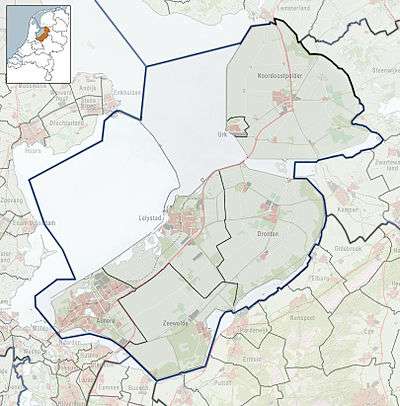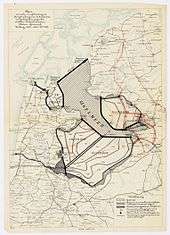Bordering lakes

- 1 - IJmeer
- 2 - Gooimeer
- 3 - Eemmeer
- 4 - Nijkerkernauw
- 5 - Nuldernauw
- 6 - Wolderwijd
- 7 - Veluwemeer
- 8 - Drontermeer
- 9 - Vossemeer
- 10 - Ketelmeer
- 11 - Ramsdiep
- 12 - Zwarte Meer
- 13 - Kadoelermeer
- 14 - Vollenhovermeer
In the Netherlands, the bordering lakes (in Dutch: Randmeren) are a chain of lakes which separate the Flevopolder from the ancient lands of the provinces of Gelderland and Utrecht and the Noordoostpolder.[1]
Strictly speaking, these 'lakes' are not separated from each other, but are a continuous narrow body of water between the old and the new polder lands, divided in name only into different lakes. Physically the dividing point may be a bridge, a lock or nothing material.
The purpose of these lakes is to isolate the management of water of the polder land from that of the neighbouring old land. When a polder is created, the ground level within it is below that of the surrounding area. If it is connected directly to the polder, the water table in ancient lands falls, which causes the soil to dry out.[2] This was observed in the Noordoostpolder, Overijssel and Friesland to the east and between the Wieringermeerpolder and North Holland.
In addition, water flows to the new polder lands, creating a very wet area, especially at the edges of the polder. Drainage may be a solution, but this only increases the problem in the old land. If a large enough bordering lake is created between polder and old land, the water pressure and level remain the same. Water in the polder will be managed independently.
Historically, this technique was not applied to the Noordoostpolder or the Wieringermeer. For the Noordoostpolder, the plan was abandoned because it was too expensive. The Wieringerrandmeer project between the Wieringermeer and Wieringen is still under discussion with the province of North Holland.
The bordering lakes surrounding the Flevopolder offer opportunities for water sports and the creation of nature reserves.
List of the bordering lakes along the Flevopolder
From south-west to the north:[1]
- IJmeer
- Gooimeer
- Eemmeer
- Nijkerkernauw
- Nuldernauw
- Wolderwijd
- Veluwemeer
- Drontermeer
- Ketelmeer
